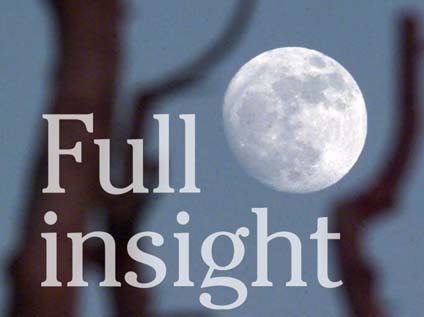
The United Japanese Society
will keep tradition alive with
a moon-viewing party
Look up at the moon and what do you see? The image revealed will offer a clue to your heritage. Where Americans see a smiling face when they look up at a full moon, those in Japan don't see the "man in the moon." According to Ken Saiki, president of the United Japanese Society of Hawaii, the pattern of light and dark spots looks more like rabbits pounding mochi to Japanese school kids, whose folk tales tell of rabbits that live on the moon.
'Tsukimi no Kai'
A moon viewing celebrationWhere: Kapiolani Community College, Ohia Building
When: 6 to 9 p.m. Friday
Admission: $30, includes a dinner buffet
Call: 941-5889
The moon's beauty and mystery led to the Chinese tradition of moon viewing, which was adopted in Japan during the Heian period. Aristocrats gathered during the August full moon to drink sake and compose poetry inspired by the occasion, said Saiki. Even the emperor led the moon-viewing parties.
The UJSH aims to keep such traditions alive, Saiki said, and toward that end the organization is hosting its own "Tsukimi no Kai," a moon-viewing celebration, at Kapiolani Community College on Friday.
Just as in ancient times, there will be sake, bamboo flute music performances, folk dancing and poetry reading to be enjoyed "under the light of the moon," he explained.
A Shinto blessing and a tea ceremony will also be a part of the celebration. "Offerings of food, flowers and autumn grass are made to the brilliant harvest moon.
"People can sit and look at the moon, drink some sake and just have fun with their family and friends."
Traditionally, the flow of sake also helps to loosen inhibitions, making it easier to expose the soul through poetry.
In Japan, the moon-viewing tradition spread from the aristocrats to samurai, townspeople, and eventually farmers, who added a religious element to the festivities, thanking gods for a bountiful harvest. The farmers would place grass, fruits, nuts, potatoes and other harvested goods in the window or on the veranda facing the moonlight.
Children are allowed to go from house to house collecting dango (round rice balls) and other treats from the neighboring homes. "They go around and collect goodies, similar to what children do on Halloween," Saiki said. "It is the one day out of the year that kids are allowed to steal. Anyone who took the fruit or dango conveniently placed on the veranda during moon viewing would be forgiven," he said.
In Japan, the tradition is disappearing, said Saiki, making it more important for those of Japanese ancestry to preserve their heritage. "Customs are fading as society changes. Tall buildings and smog may make it impossible to see the moon."
The KCC moon viewing will end with a bon dance. "Everyone goes under the full moon and dances in circles," Saiki said. "It's our fifth annual Tsukimi and it gets bigger and better each year."
Click for online
calendars and events.

